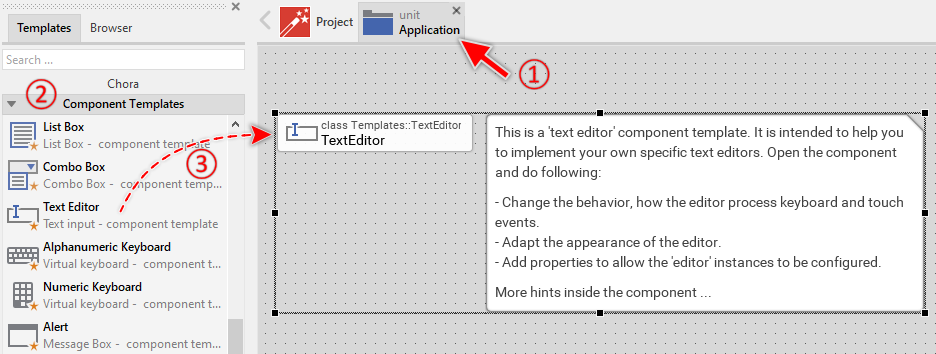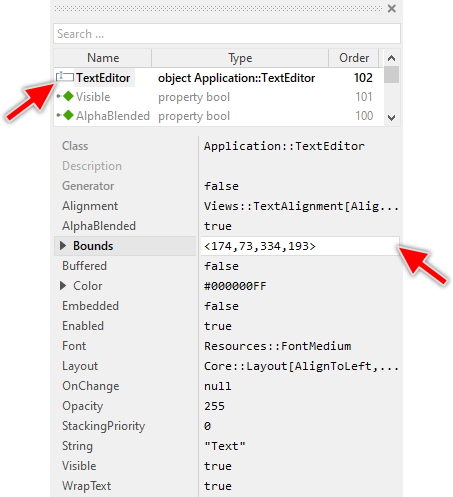Creating components from templates: Text Editor
With this template you can add a new Text Editor component to your project. Text Editor provides functionality to enter, edit and delete text - be it single or multiline. The user can scroll the text by using the keyboard or by touching the screen. When the user touches the screen for a while, a magnifying glass appears permitting the user to move the caret directly with the finger. Each time the user modifies the text in the Editor, the component sends signals to associated slot methods where your particular implementation is executed.
Components created with this template are intended to be adapted to your particular design expectations. After adding the new Text Editor you should edit the component, change its appearance and if desired also its behavior. Once you have adapted the component, you can embed instances of this Text Editor wherever you need in your GUI project. Because it serves as template, it is intentionally kept very simple. Nevertheless, Text Editors created by the template are working widgets. If desired, they can already be used as they are. The following figure demonstrates the default appearance of the Text Editor created by using the here described component template:

The approach with component templates has two functions. Primarily the templates should simplify the development of new components. Instead of creating the Text Editor from scratch you can use the available template. The second function is more educative. The template implements fully working Text Editor component you can investigate and learn about the corresponding programming aspects. The template is well documented. It contains annotations and inline comments with instructions helping you to understand how the component works and how it can be adapted to your particular needs.
This chapter provides an overview how the Text Editor component template is used within your own application and how you adapt this component according to your particular needs. You will find here also further details concerning the internal implementation of the Text Editor component.
Add new Text Editor component
To create a new Text Editor component from a template you simply Drag & Drop it between the Templates window and the Composer with an opened unit. This is important in that by using the component templates you add in fact a new class to your project. Classes, in turn, can exist within units only. The following are the typical steps to create a new Text Editor component from a template:
★First switch to the Composer page for the respective unit, where you want to add the new Text Editor component.
★Then ensure that the Templates window is visible.
★In Templates window switch to the folder Component Templates.
★In the folder locate the Text Editor template.
★Drag & Drop the template into the Composer window:

★Eventually name the new added component.
The new created Text Editor component appears accompanied by annotation providing helpful tips how to proceed. If undesired, you can select and delete the annotation.
Use the Text Editor component
Once you have created the Text Editor component, you can use it to assemble more complex components. Technically seen, you embed an instance of the Text Editor class in-place within some superior GUI component. At the runtime, the superior GUI component takes care of the correct initialization and the displaying of all embedded components, so they appear similarly as you have composed them at the design time.
Step 1. Add new Text Editor instance
The following are the typical steps to create a new instance of an already existing Text Editor component:
★First switch to the Composer page for the respective GUI component, where you want to add the new Text Editor.
★Then ensure that the Browser window is visible.
★Within the Browser locate the class of the previously created Text Editor. This can be done easily with Browser's own filter function.
★Select the found class in the Browser window.
★Drag & Drop the selected class into the Composer area.

★Eventually name the new instance according to its function within the GUI component (e.g. FirstName).
Component templates are intended to create widgets which can be modified and adapted to your particular design expectations. In the following sections you will learn how to do this. Originally, if not yet modified, the Text Editor displays only the text. At the runtime a blinking caret symbol is shown. Our intention is to keep the component templates as minimalistic as possible so they don't distract you with less important design details.
Step 2. Inspect the Text Editor instance
As long as the Text Editor is selected you can inspect and modify its properties conveniently in the Inspector window as demonstrated with the property Bounds in the screenshot below. This is in so far worth mentioning as diverse features of the Text Editor are controlled by the corresponding properties. If you are not familiar with the concept of a property and the usage of Inspector window, please read first the preceding chapter Compositing component appearance.

The Text Editor component descends from the Mosaic class Core::Group. Consequently, most of the properties listed in the above screenshot are inherited from this base class. Particular to the Text Editor are only few following properties:
Property |
Description |
|---|---|
Alignment |
The property Alignment determines how the editor should display the text rows if their size differs from the size of the editor. In this manner the rows can be aligned horizontally. The entire text block can be aligned vertically. |
Color |
The property Color controls the color of the text and the blinking caret. |
Font |
The property Font refers to the font object used to display the text. The text is determined by the property String. |
OnChange |
The property OnChange can refer to a slot method, which should be invoked by the text editor when the user modifies the text. |
String |
The property String stores the text of the editor. |
WrapText |
The property WrapText determines whether long text rows should be wrapped automatically. |
Step 3. Arrange the Text Editor within the superior component
Once added to the component, you can freely move the Text Editor instance, or you simply grab one of its corners and resize it in this way. You can control the position and the size of the component also by directly modifying its property Bounds. If you want the Text Editor to appear behind other views you can reorder it explicitly.
IMPORTANT
Please note, this document is actually UNDER CONSTRUCTION. It is incomplete. We are working on it ...
